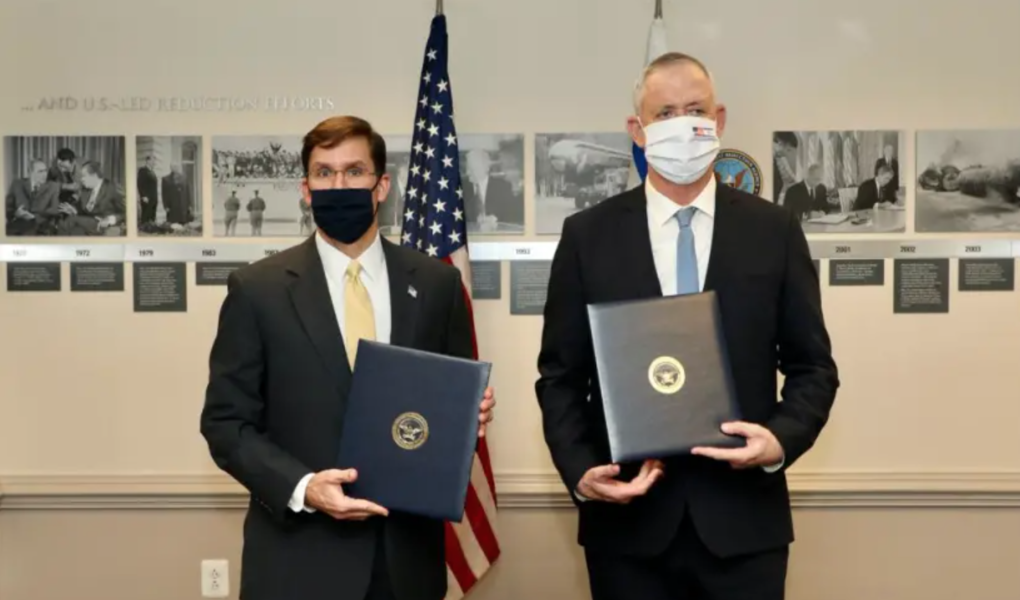What did Gantz bring back with him from Washington?
By Anna Ahronheim
Defense Minister Benny Gantz flew back from his second trip to Washington claiming success: Israel’s qualitative military edge has been preserved for decades to come. There was even a photo shoot showing him alongside his US counterpart, Secretary of Defense Mark Esper, holding a black folder.
But what was in that folder? What was the game-changer that was agreed to with Washington to allow Jerusalem to retain its QME?
On Monday, the Ministerial Committee for Defense Procurement met for the first time after being formed earlier in the month to discuss the agreement that was signed in Washington.
The committee is made up of Prime Minister Benjamin Netanyahu, Gantz, Finance Minister Israel Katz, Foreign Minister Gabi Ashkenazi, Education Minister Yoav Gallant, and Economy and Industry Minister Amir Peretz.
The committee is responsible for giving the green light for any large-scale defense procurement by Israel, and will likely meet again several times before any purchase is given the green light.
According to Maj.-Gen. (ret.) Yaakov Ayish, senior vice president for Israeli affairs at the Jewish Institute for National Security of America (JINSA), the committee members likely asked the treasury and committee to give them permission to go through with a multi-year procurement deal without deciding on a platform.
Though the Defense Ministry and the military have had more than four years to decide on “what platform they want, how many of them, and the sequence” in which to integrate them into the IAF, he said, “they want a general approval that will portray a framework that they can work with for the coming years and then come up with the platform they want.”
Former Air Force head and current director-general of the Defense Ministry, Maj.-Gen. (ret.) Amir Eshel was essential in the decision-making process and procurement of the F-35 and is now “trying to push it forward and execute the procurement deals,” Ayish said.
Speaking to reporters before Gantz returned to Israel, a senior source familiar with the talks was tight-lipped about what was signed, revealing only that Bell Boeing’s V-22 Osprey was once again on the table for the Israel Air Force.
The V-22 has been on and off the table for years, and while it may be a great addition to the IAF, it is no game-changer. According to a report in Haaretz, IAF head Maj.-Gen. Amikam Norkin is not interested in the platform.
It must have been something else, something much more dramatic, especially if the defense ministry is keeping it hush-hush.
Another purchase that is on the table is an additional 10 F-35 stealth fighter jets. Israel currently has 50 of them, with an expected 75 in the coming years, so another 10 would not be a game-changer, especially since it won’t even give Israel another full squadron.
But, what if those extra 10 F-35s are the F-35B short takeoff/vertical landing jets?
Israel has expressed interest in the past in acquiring the F-35B, which has the capabilities for vertical takeoff and landings, an option which can allow the jet to land on much shorter runways if the IAF’s bases are attacked by Iranian jets or missiles from Hezbollah.
Israel’s Air Force is currently in the process of upgrading its squadrons of fighter jets, and the F-35 and the F-15ix are the top candidates. Procuring a small number of F-35Bs could make sense, but would it really be such a big deal that the defense establishment is keeping quiet?
What if Gantz got Esper to agree to an additional clause… that allows Israel to have full control over the plane’s internal computer mainframe? No country but the United States has access to the brain of the plane and it would allow Israel to modify the plane without the Americans knowing.
Three squadrons (perhaps four) of F-35As as well as 10 F-35Bs and access to the computer’s mainframe – now that would be a big deal.
But would it be enough to maintain Israel’s QME?
“What you see in the media is what the two sides want to expose to the media,” Ayish said, adding that “there are things they want to keep hidden.”
And with the US election around the corner, Jerusalem may be trying to get whatever they can get out of the Trump administration.
“It’s quite obvious, or else why would Gantz fly to the states twice in the past month? Gantz flew in once, sent in his working team, then flew in to sign the deal. He’s trying his best to get what he needs,” Ayish said.
Ayish said JINSA has promoted the idea to start the discussion surrounding a new Memorandum of Understanding (MOU), which would allow Israel to have a framework and the freedom to decide and finance future procurement plans.
That, he said, “is a very strong and powerful strategic signal by the United States that they support Israel in the next decade and it will allow the Israel Air Force to continue to upgrade its capabilities.”
According to Ayish, who served as Israeli defense attaché to the United States and Canada, as well as head of the IDF General Staff Operations Branch, a new MOU would allow Israel to obtain deferred payments and low interests on future major platform purchases.
The agreement with Washington could have also secured the ability to frontload platforms, giving the IAF the fighter jets, helicopters and transport planes now with the ability to pay later. The replenishing and upgrading of the prepositioned precision-guided munition stockpiles that the US keeps in Israel would also save time for Jerusalem by having immediate access to them in the case of a full-scale encounter with the north or with Iran.
Either of those would bolster Israel’s strategic and defensive situation.
Now put those options together with a possible new MOU that extends American funds for defense procurement until 2038, new aerial platforms, and there we might find that reason why Gantz came back from Washington reassured that he’s secured Israel’s QME.
Because, Ayish stressed, “Israel has to be able to defend itself, by itself, at any given time. We should not play with this.”
Originally published in The Jerusalem Post

